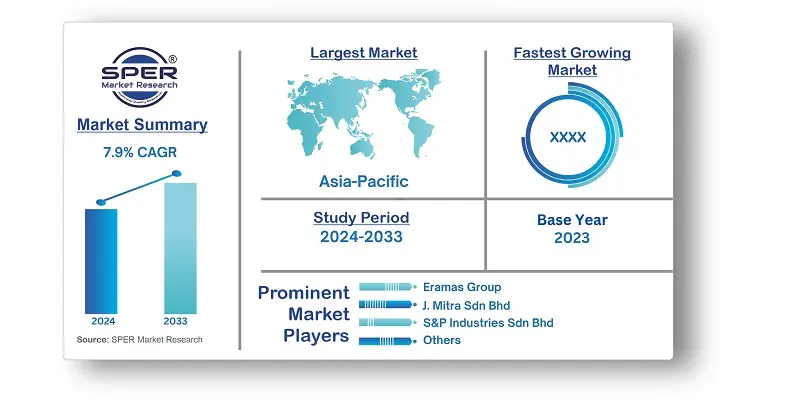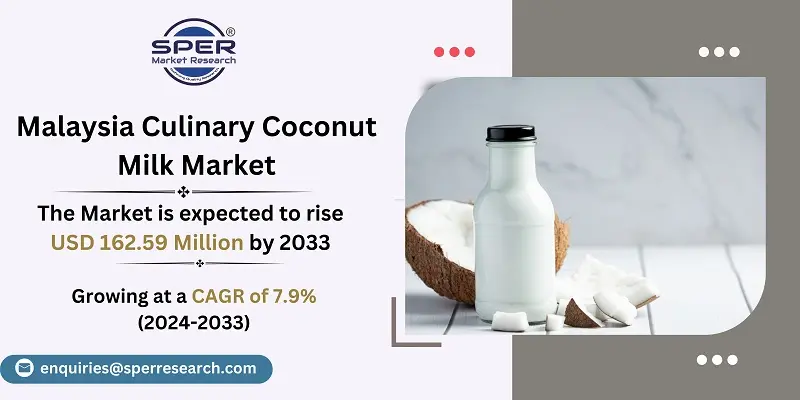
Malaysia Culinary Coconut Milk Market Growth, Size, Trends, Demand, Revenue and Future Outlook
Malaysia Culinary Coconut Milk Market Size- By Product Type, By Form, By Distribution Channel- Regional Outlook, Competitive Strategies and Segment Forecast to 2033
| Published: Mar-2024 | Report ID: FOOD2438 | Pages: 1 - 102 | Formats*: |
| Category : Food & Beverages | |||
- May 2022, M&S Coconut, a Malaysian gourmet coconut milk and cream business, has introduced new coconut cream items. These goods are available in a variety of container sizes.
- August 2021, Nespresso Malaysia has launched a collaboration with Crème De La Crème, an artisanal local ice cream parlour, to introduce coffee and coconut-infused ice cream.
- August 2020, Century Pacific Food entered into a long-term arrangement with Linaco Group to expand its footprint in Malaysia and other Asian, Middle Eastern, and European countries. This agreement will expand both companies' coconut product production capacity.


| Report Metric | Details |
| Market size available for years | 2020-2033 |
| Base year considered | 2023 |
| Forecast period | 2024-2033 |
| Segments covered | By Product Type, By Form, By Distribution Channel |
| Regions covered | East Malaysia, Northern States |
| Companies Covered | Denis Group Holding S.A., Eramas Group, Gogoco Holding Sdn Bhd, J. Mitra Sdn Bhd, Kara Marketing Sdn Bhd, Linaco Manufacturing (M) Sdn Bhd, M&S Food Industries Sdn Bhd, S&P Industries Sdn Bhd, Santanmas Food Industries (M) Sdn Bhd, Tropical Produce Sdn Bhd, Others |
- Food and Beverage Manufacturers
- Restaurants and Catering Services
- Retailers and Supermarkets
- Health-Conscious Consumers
- Vegan and Vegetarian Consumers
- Individuals with Lactose Intolerance or Dairy Allergies
- Nutrition and Wellness Experts
- Food Ingredient Suppliers
- Others
| By Product Type: |
|
| By Form: |
|
| By Distribution Channel: |
|
- Malaysia Culinary Coconut Milk Market Size (FY’2024-FY’2033)
- Overview of Malaysia Culinary Coconut Milk Market
- Segmentation of Malaysia Culinary Coconut Milk Market By Product Type (Coconut Cream, Coconut Cream Powder, Coconut Milk, Coconut Milk Powder)
- Segmentation of Malaysia Culinary Coconut Milk Market By Form (Liquid, Powder)
- Segmentation of Malaysia Culinary Coconut Milk Market By Distribution Channel (Convenience Stores, Grocery Stores, Online Retails, Supermarkets/Hypermarkets)
- Statistical Snap of Malaysia Culinary Coconut Milk Market
- Expansion Analysis of Malaysia Culinary Coconut Milk Market
- Problems and Obstacles in Malaysia Culinary Coconut Milk Market
- Competitive Landscape in the Malaysia Culinary Coconut Milk Market
- Impact of COVID-19 and Demonetization on Malaysia Culinary Coconut Milk Market
- Details on Current Investment in Malaysia Culinary Coconut Milk Market
- Competitive Analysis of Malaysia Culinary Coconut Milk Market
- Prominent Players in the Malaysia Culinary Coconut Milk Market
- SWOT Analysis of Malaysia Culinary Coconut Milk Market
- Malaysia Culinary Coconut Milk Market Future Outlook and Projections (FY’2024-FY’2033)
- Recommendations from Analyst
1.1. Scope of the report1.2. Market segment analysis
2.1. Research data source2.1.1. Secondary Data2.1.2. Primary Data2.1.3. SPER’s internal database2.1.4. Premium insight from KOL’s2.2. Market size estimation2.2.1. Top-down and Bottom-up approach2.3. Data triangulation
4.1. Driver, Restraint, Opportunity and Challenges analysis4.1.1. Drivers4.1.2. Restraints4.1.3. Opportunities4.1.4. Challenges4.2. COVID-19 Impacts of the Malaysia Culinary Coconut Milk Market
5.1. SWOT Analysis5.1.1. Strengths5.1.2. Weaknesses5.1.3. Opportunities5.1.4. Threats5.2. PESTEL Analysis5.2.1. Political Landscape5.2.2. Economic Landscape5.2.3. Social Landscape5.2.4. Technological Landscape5.2.5. Environmental Landscape5.2.6. Legal Landscape5.3. PORTER’s Five Forces5.3.1. Bargaining power of suppliers5.3.2. Bargaining power of buyers5.3.3. Threat of Substitute5.3.4. Threat of new entrant5.3.5. Competitive rivalry5.4. Heat Map Analysis
6.1. Malaysia Culinary Coconut Milk Market Manufacturing Base Distribution, Sales Area, Product Type6.2. Mergers & Acquisitions, Partnerships, Product Launch, and Collaboration in Malaysia Culinary Coconut Milk Market
7.1. Malaysia Culinary Coconut Milk Market Value Share and Forecast, By Product Type, 2024-20337.2. Coconut Cream7.3. Coconut Cream Powder7.4. Coconut Milk7.5. Coconut Milk Powder
8.1. Malaysia Culinary Coconut Milk Market Value Share and Forecast, By Form, 2024-20338.2. Liquid8.3. Powder
9.1. Malaysia Culinary Coconut Milk Market Value Share and Forecast, By Distribution Channel, 2024-20339.2. Convenience Stores9.3. Grocery Stores9.4. Online Retails9.5. Supermarkets/Hypermarkets
10.1. Malaysia Culinary Coconut Milk Market Size and Market Share
11.1. Malaysia Culinary Coconut Milk Market Size and Market Share By Product Type (2020-2026)11.2. Malaysia Culinary Coconut Milk Market Size and Market Share By Product Type (2027-2033)
12.1. Malaysia Culinary Coconut Milk Market Size and Market Share By Form (2020-2026)12.2. Malaysia Culinary Coconut Milk Market Size and Market Share By Form (2027-2033)
13.1. Malaysia Culinary Coconut Milk Market Size and Market Share By Distribution Channel (2020-2026)13.2. Malaysia Culinary Coconut Milk Market Size and Market Share By Distribution Channel (2027-2033)
14.1. Malaysia Culinary Coconut Milk Market Size and Market Share By Region (2020-2026)14.2. Malaysia Culinary Coconut Milk Market Size and Market Share By Region (2027-2033)14.3. East Malaysia14.4. Northern States
15.1. Denis Group Holding S.A.15.1.1. Company details15.1.2. Financial outlook15.1.3. Product summary15.1.4. Recent developments15.2. Eramas Group15.2.1. Company details15.2.2. Financial outlook15.2.3. Product summary15.2.4. Recent developments15.3. Gogoco Holding Sdn Bhd15.3.1. Company details15.3.2. Financial outlook15.3.3. Product summary15.3.4. Recent developments15.4. J. Mitra Sdn Bhd15.4.1. Company details15.4.2. Financial outlook15.4.3. Product summary15.4.4. Recent developments15.5. Kara Marketing Sdn Bhd15.5.1. Company details15.5.2. Financial outlook15.5.3. Product summary15.5.4. Recent developments15.6. Linaco Manufacturing (M) Sdn Bhd15.6.1. Company details15.6.2. Financial outlook15.6.3. Product summary15.6.4. Recent developments15.7. M&S Food Industries Sdn Bhd15.7.1. Company details15.7.2. Financial outlook15.7.3. Product summary15.7.4. Recent developments15.8. S&P Industries Sdn Bhd15.8.1. Company details15.8.2. Financial outlook15.8.3. Product summary15.8.4. Recent developments15.9. Santanmas Food Industries (M) Sdn Bhd15.9.1. Company details15.9.2. Financial outlook15.9.3. Product summary15.9.4. Recent developments15.10. Tropical Produce Sdn Bhd15.10.1. Company details15.10.2. Financial outlook15.10.3. Product summary15.10.4. Recent developments15.11. Others
SPER Market Research’s methodology uses great emphasis on primary research to ensure that the market intelligence insights are up to date, reliable and accurate. Primary interviews are done with players involved in each phase of a supply chain to analyze the market forecasting. The secondary research method is used to help you fully understand how the future markets and the spending patterns look likes.
The report is based on in-depth qualitative and quantitative analysis of the Product Market. The quantitative analysis involves the application of various projection and sampling techniques. The qualitative analysis involves primary interviews, surveys, and vendor briefings. The data gathered as a result of these processes are validated through experts opinion. Our research methodology entails an ideal mixture of primary and secondary initiatives.



Frequently Asked Questions About This Report
PLACE AN ORDER
Year End Discount
Sample Report
Pre-Purchase Inquiry
NEED CUSTOMIZATION?
Request CustomizationCALL OR EMAIL US
100% Secure Payment






Related Reports
Our Global Clients
Our data-driven insights have influenced the strategy of 200+ reputed companies across the globe.




















